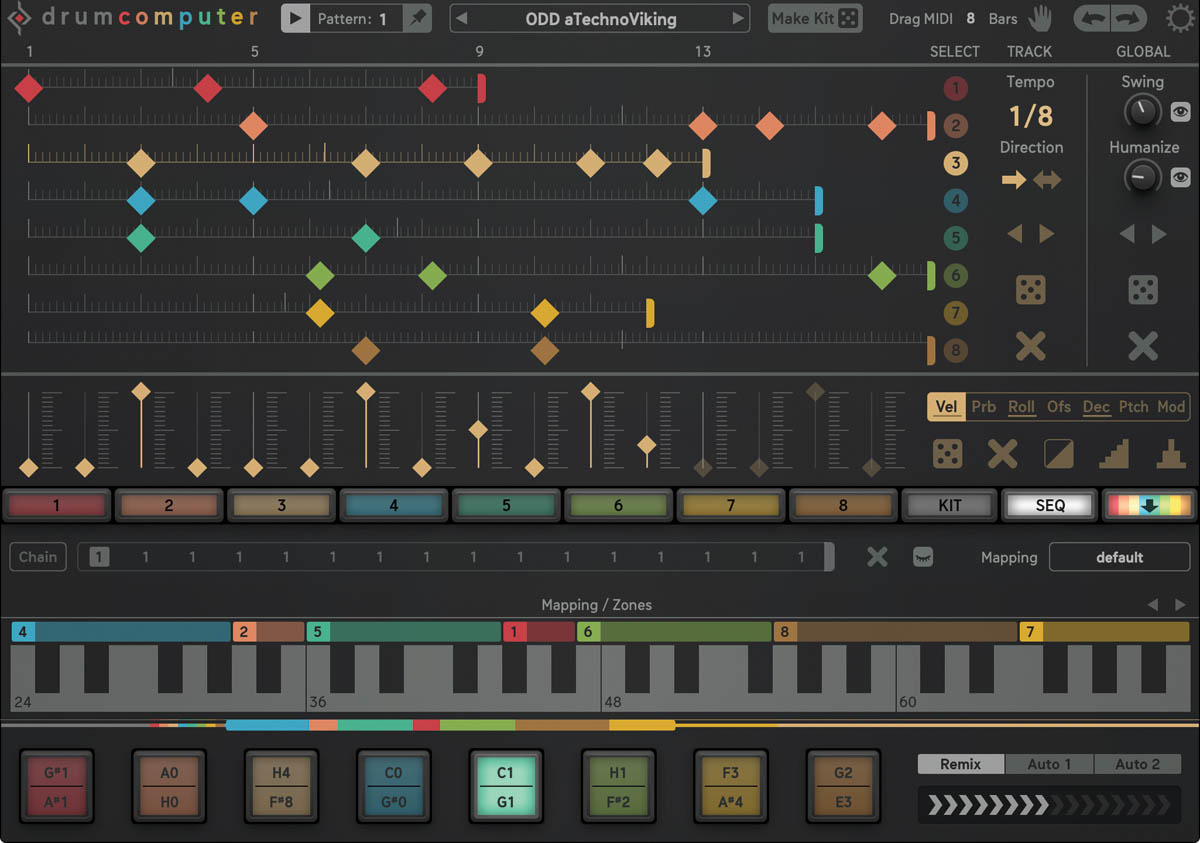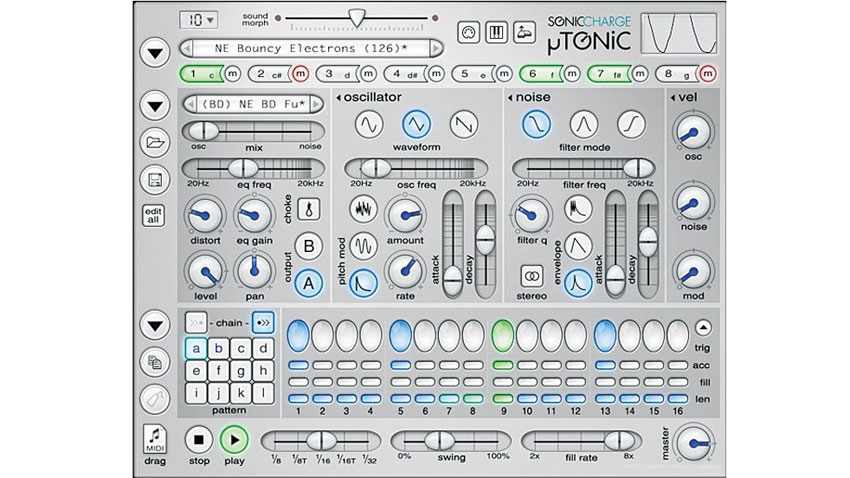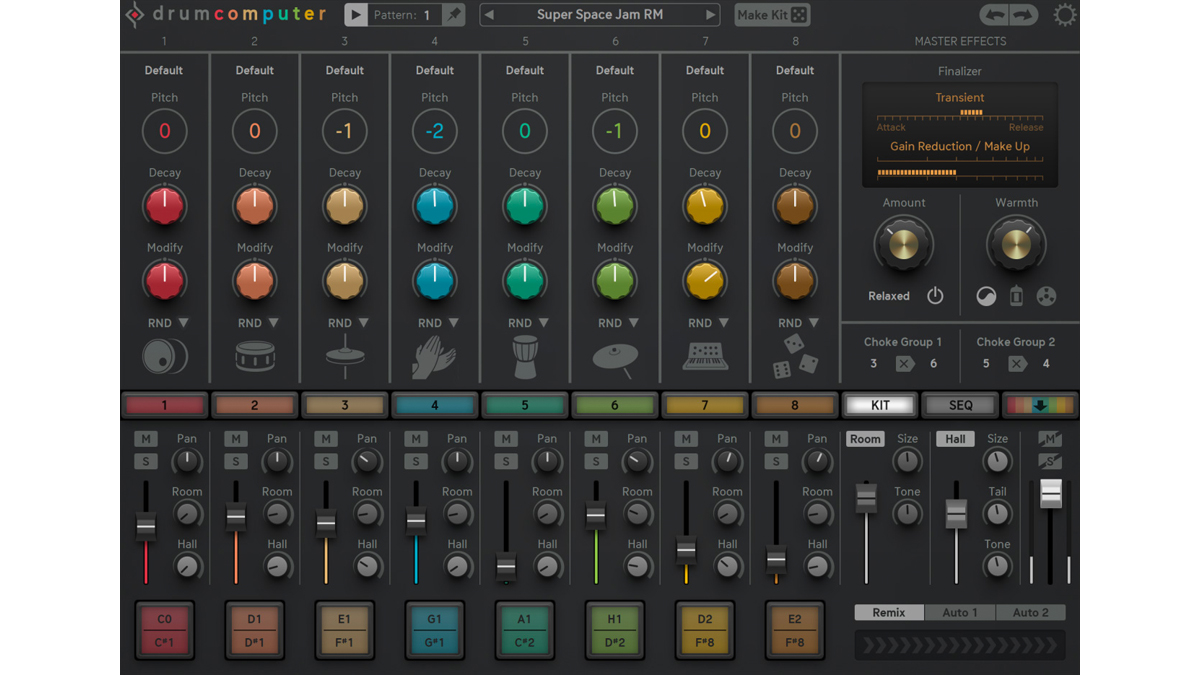MusicRadar Verdict
It’s not for everyone, but DrumComputer’s singular sound makes it a fine addition to the software percussion landscape.
Pros
- +
Three synth engines work well.
- +
Has a sonic personality all its own.
- +
Fantastic sequencer.
- +
Plenty of randomisation.
- +
Automatic fill generation and ‘remixing’.
Cons
- -
Modulation not visualised.
- -
Can feel overly idiosyncratic at times.
- -
Not the best choice for modern dance music sounds.
MusicRadar's got your back
What is it?
In a market awash with hard-hitting sample-based drum instruments, the release of any serious synth-powered alternative is always something to celebrate.
While DrumComputer (VST/AU/AAX/Standalone) does use bits of audio samples as raw sound sources, it’s a synth in the purest sense, and the upshot is a beatbox with real character and personality.
DrumComputer is an eight-channel/engine drum machine with onboard step sequencing. All eight engines are identical in their parameters and layout, and each hosts a trio of drum-specific synth modules, which are blended to make the individual elements of your kit.
The three modules are the “808-inspired” Resonator, the dual-mode Wavetable/Analogue, and the wholly digital Resynth. Although there are no rules as to how they’re used together, the general idea is to define the transient of the drum with the Resonator, the body with the Wavetable/Analogue, and the tail/snare wires with the Resynth module.
While DrumComputer does use bits of audio samples as raw sound sources, it’s a synth in the purest sense, and the upshot is a beatbox with real character and personality.
All three have a few common controls, including Level, Pitch, Pitch Mod and Decay, and a switch for making the pitch envelope velocity-sensitive, but some of these vary in their specifics between modules.
The Resonator feeds one of four ‘exciter’ signals into a self-oscillating multimode (LP/BP/HP) filter, with adjustable cutoff (Pitch) and resonance, and the Decay knob controlling the exciter/noise length.
The Envelope exciter sends an impulse to the filter, which resonates as a sine wave in response; Noise + Env does the same but with added noise; and Wavetable and Resynth use the output of either of the other two modules as the exciter, whether that module itself is audible or not.

The Partials knob increasingly raises the frequency and volume of two additional voices, while Tone applies a 12dB/octave low-pass filter for frequency sculpting.
The Wavetable/Analogue module presents two oscillator options: an analogue waveform, morphing from sine to pulse, with PWM; or one of an extensive list of wavetables to which you can add your own in WAV/AIF format, with 16 waves extracted from the imported sample.
The waveform or wavetable position is morphed/swept using the central knob, which is of course available as a modulation target (see below); eight invertible pitch modulation/decay envelope shapes are on hand; and frequency and bipolar ring modulation can be brought to bear for ‘metalising’ and inharmonic tonal manipulation, sourced from the Resonator and an internal sine wave oscillator respectively.
Randomisation of any individual engine or the whole kit is a click away
Last but by no means least, the Resynth module turns a single-cycle waveform (from the huge included library or extracted from an imported sample) into a ‘noise table’ – a looping wave with no discernible pitch. Set the length and frequency movement of the noise with Decay and Pitch Mod, and dial in a combo low/ high-pass filter with the Color knob, to generate snare sounds, cymbals, shakers and the like.
Performance and verdict
The three modules meet at an effects section, where a multimode (including Vowel) filter, compression, distortion and two bands of EQ are applied. And when you’re stuck for ideas, randomisation of any individual engine or the whole kit is a click away, each Engine’s Profile setting guiding the randomisation to keep it within the sonic bounds of a particular drum type – Kick, Snare, Clap, Perc, Hat, Cymbal or Synth – should you so choose.
Levelling, panning, muting and soloing of the engines is done in the Mixer section at the bottom, which also houses auxiliary Room and Hall reverbs. Multiple outputs to the host DAW are provided, too, for external processing.

• Sonic Charge Microtonic 3
This virtual analogue drum machine is a modern classic.
• XILS-lab StiX
Powered by an extensive roster of synthesis techniques and sampling.
Each DrumComputer engine packs in a surprising amount of modulation into its central strip. Two Modulation Generators serve as envelopes or LFOs, assignable to two parameters each from their own control panels; and a four-slot modulation matrix enables a wide range of sources (MGs, sequencer, the audio output of each module, MIDI data, randomisers, etc) to target any four parameters from that engine.
It’s an incredibly flexible setup with which a huge degree of automative control can be imposed on the eight engines – although with modulation only visualised for the Wavetable/ Analogue module’s waveform, the system falls slightly short of the mark in terms of intuitiveness and navigational workflow.
We’re almost out of space, so let’s wrap up with a quick run-down of DrumComputer’s other notable features. The Kit page gives access to the Pitch, Decay and Modify mod source controls for all eight Engines at once, as well as choke groups and a useful Finalizer effect (transient shaping, dynamics and distortion).
The clever keyboard control scheme facilitates hands-on control of pattern switching, mutes, note pitching and variable-speed rolls. And the Roll and Flam features are great for live performance and sequence embellishment.
We’re almost out of space, so let’s wrap up with a quick run-down of DrumComputer’s other notable features. The Kit page gives access to the Pitch, Decay and Modify mod source controls for all eight Engines at once, as well as choke groups and a useful Finalizer effect (transient shaping, dynamics and distortion).
The clever keyboard control scheme facilitates hands-on control of pattern switching, mutes, note pitching and variable-speed rolls. And the Roll and Flam features are great for live performance and sequence embellishment.
MusicRadar verdict: It’s not for everyone, but DrumComputer’s singular sound makes it a fine addition to the software percussion landscape.
The web says
"DrumComputer’s powerful three-tiered synth engine produces sounds unlike anything we’ve heard so far in similar instruments, and the sequencer might be the most flexible rhythm machine you can find."
Bedroom Producers Blog
Hands-on demos
Plugin Boutique
Sugar Bytes
Specifications
- Type: Synthetic drum machine plugin (VST/AU/AAX/Standalone)
- Key Features: 8 Sound Engines, each one layering a Resonator, Wavetable and Resynth; Filter, Compressor, Overdrive, Room and Hall send reverbs; 2x Env/LFO, plus Synth-Engine-Modulators, Sequencer-Modulators, ModMatrix; Intelligent Randomizers for endless Drum Sounds; 16 Step Sequencer and Pattern Generator, Probability, Rolls, +/- Step Delay, Swing, Humanize; Auto- und Manual Remixing/Fills; Easy Keyboard Mapping for Patterns, Mutes and Engine Triggers; Keyzones for Rolls, Pitch and Modulation; MIDI File Drag & Drop; Multiple Audio/MIDI Outputs
- System requirements: MacOS 10.9 or higher (Audio Unit, VST2, AAX, Standalone), Windows 7 or higher (VST2, AAX, Standalone)
- Contact: Sugar Bytes
Computer Music magazine is the world’s best selling publication dedicated solely to making great music with your Mac or PC computer. Each issue it brings its lucky readers the best in cutting-edge tutorials, need-to-know, expert software reviews and even all the tools you actually need to make great music today, courtesy of our legendary CM Plugin Suite.
“A synthesizer that is both easy to use and fun to play whilst maintaining a decent degree of programming depth and flexibility”: PWM Mantis review
“I feel like that song had everything we needed to come back with”: Bring Me The Horizon’s Lee Malia on Shadow Moses, its riff and the secrets behind its tone, and why it was the right anthem at the right time
“I said, ‘Are we sure we can write a song about death?’”: The story of Mike + The Mechanics' classic No.1 The Living Years











